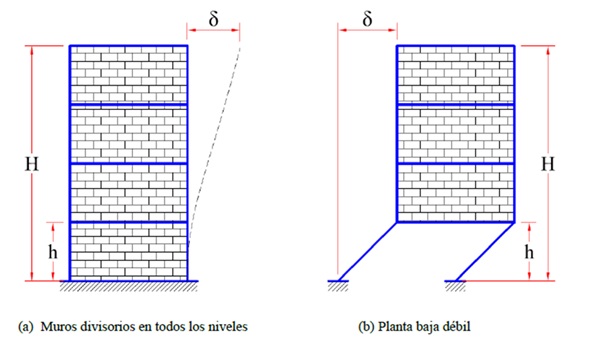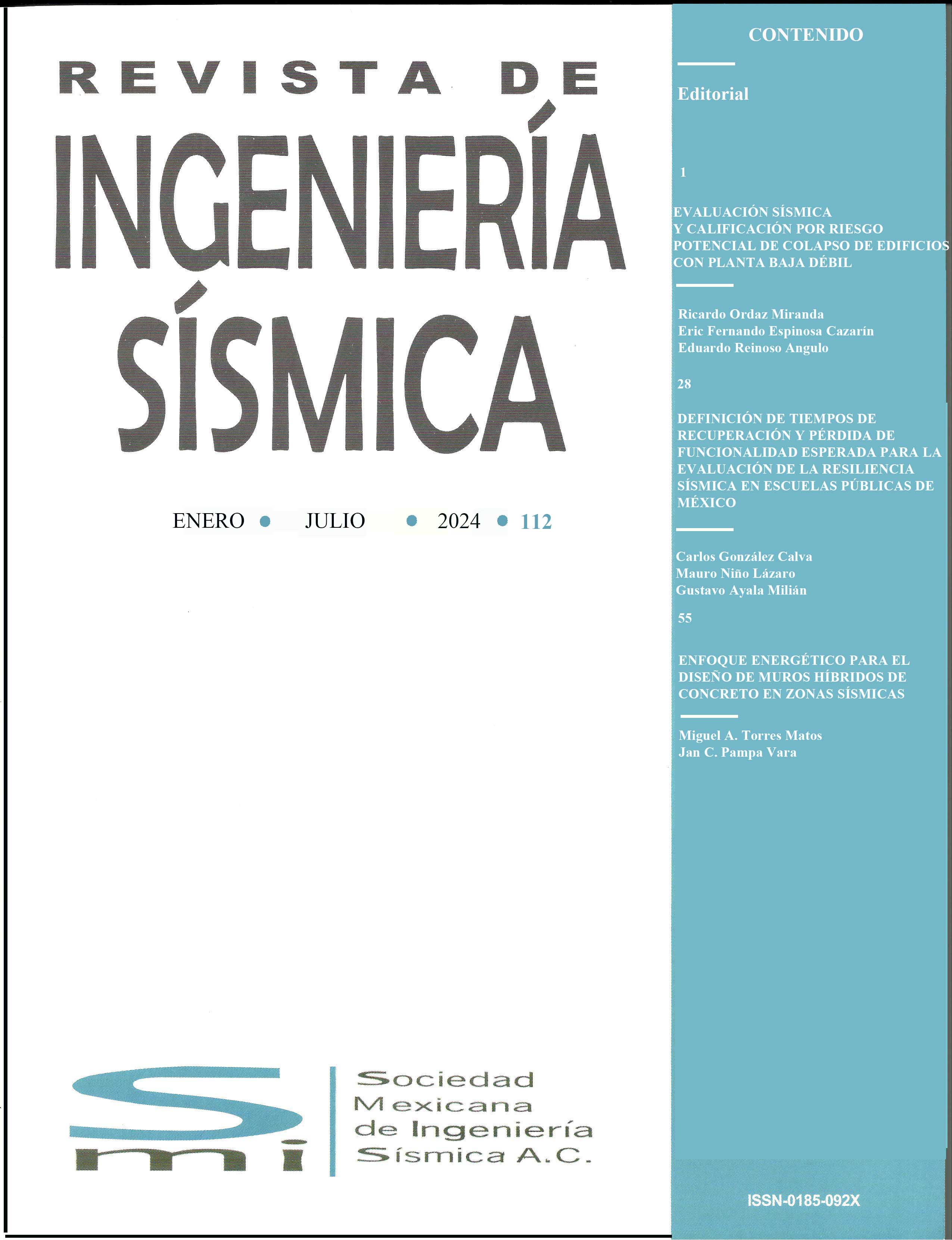REQUIREMENTS FOR DISTORTION CONTROL, DUCTILITY, STRENGTH AND STRUCTURAL IRREGULARITY IN THE SEISMIC DESIGN STANDARDS OF MEXICO CITY
DOI:
https://doi.org/10.18867/ris.114.669Keywords:
Seismic design standards, drift control, ductility, strength, structural irregularityAbstract
This work reviews some requirements of seismic design standards in recent decades in Mexico City, from 1957 to date, grouping them before and after the 1985 earthquake. The topics considered are distortion control, ductility, resistance, and structural irregularity. In some cases, the requirements discussed are compared to those specified in some United States standards.
The topics of distortion control, ductility, and lateral resistance are studied in accordance with current practice. Simple procedures are used for the nonlinear dynamic analysis of reinforced concrete structures that respond to a typical record of soft soil in Mexico City. These structures are based on frames and structural walls, considering the cases of low and high-ductility structures. The results found for the cases studied indicate that the common practice in Mexico of designing only considering Q=2 must change and that the design of high ductility structures is preferable.Finally, suggestions are made to update some requirements of the current Standard.
Downloads
References
ACI 318-19 (2019). “Building Code Requirement for Reinforced Concrete”. American Concrete Institute.
ASCE/SEI 7-16 (2017), “Minimum Design Loads for Buildings and Other Structures”, American Society of Civil Engineers, Estados Unidos.
Binder, R. W., y Wheeler, W. T. (1960). “Building Code Provisions for Aseismic Design.” Proceedings of the Second World Conference on Earthquake Engineering, Tokyo (pp. 1843-1875).
Blume, John E., Newmark, N. M, y Corning, Leo H. (1961), “Design of Multi-Story Reinforced Concrete Buildings for Earthquake Motions,” Portland Cement Association, Skokie, IL.
Cabrera, J.L.; Ruiz, S.E.; y Teran-Gilmore, A. (2024). “Open Ground Story Mid-Rise Buildings Represented by Simplified Systems. Buildings,” 14, 1269. https://doi.org/10.3390/buildings14051269.
Carr, A. (2011), “RUAUMOKO, Computer Program Library”, University of Canterbury, Department of Civil Engineering.
Cecen, H. (1979), “Response of Ten Story, Reinforced Concrete Model Frames to Simulated Earthquakes”, Tesis para obtener el grado de Doctor en la Escuela de Graduados de Ingeniería Civil de la University of Illinois at Urbana-Champaign, Estados Unidos. http://hdl.handle.net/2142/66859
Clough, R. (1966), “Effect of Stiffness Degradation on Earthquake Ductility Requirements”. Structural and Material Research, Department of Civil Engineering, Report No. 66-16, University of California, Berkeley, California.
Diario Oficial de la Federación (1957), Normas de Emergencia de 1957 DF, https://smie.com.mx/smie-2022/informacion-tecnica/estados/reglamentos-construccion-ciudad-de-mexico.php
Diario Oficial de la Federación (1966), Reglamento de Construcciones para el Distrito Federal, https://smie.com.mx/smie-2022/informacion-tecnica/estados/reglamentos-construccion-ciudad-de-mexico.php
Diario Oficial de la Federación (1976), Reglamento de Construcciones para el Distrito Federal, https://smie.com.mx/smie-2022/informacion-tecnica/estados/reglamentos-construccion-ciudad-de-mexico.php
Diario Oficial de la Federación (1987), Reglamento de Construcciones para el Distrito Federal.
Gaceta Oficial del Distrito Federal (2004), Normas Técnicas Complementarias para Diseño por Sismo.
Gaceta Oficial de la Ciudad de México (2017), Normas Técnicas Complementarias para Diseño por Sismo.
Gaceta Oficial de la Ciudad de México (2017), Normas Técnicas Complementarias para Diseño y Construcción de Estructuras de Concreto.
International Conference of Building Officials, (1961), “Uniform Building Code”, 1961 Edition, Volume 1, Los Angeles, California, https://archive.org/details/UniformBuildingCode1961.
Martinelli, P. y F. Filippou (2009), “Simulation of the shaking table test of a seven-story shear wall building”, Earthquake Engineering-Structural Dynamics, Vol. 38, pp. 587-607. DOI: 10.1002/eqe.897
Panagiotou, M. (2008), “Seismic Design, Testing, and Analysis of Reinforced Concrete Wall Buildings”, Tesis Doctoral, University of California, San Diego, USA, supervisada por J. Restrepo.
Pujol, S., y Rodriguez, M.E. (2019), “Evaluación del comportamiento de muros no estructurales en edificios de la Ciudad de México en el terremoto del 19 de septiembre 2017”, Revista de Ingenieria Sísmica, No 101, 53-66. DOI: 10.18867/ris.101.529
Restrepo, J., Rodríguez, M., Nuñez, J. y Reinoso, E., (2023). “Método sencillo para considerar la irregularidad de estructuras en el diseño sismorresistente. Aplicación en la determinación de aceleraciones de piso para el diseño sísmico de diafragmas, apéndices, y elementos no estructurales en edificios”; Revista Ingeniería Sísmica, No 111. DOI: 10.18867/ris.111.662
Rodriguez C., M. (1956), “Aseismic Design of Simple Plastic Steel Structures Founded on Firm Ground”, Proceedings World Conference Earthquake Engineering, Berkeley, California.
Rodríguez, M. y Restrepo J., (2012), “Practica y diseño sísmico de edificios en México. Cambios necesarios”, Revista de Ingenieria Sísmica, No 86, 89-112.
Rodriguez, M. (2016) “Una revisión crítica de la práctica de diseño por sismo de estructuras en Mexico”, Revista de Ingenieria Sismica, No 94, 27-48
Rodriguez, M.E. (2020). “The interpretation of cumulative damage from the building response observed in Mexico City during the September 19, 2017 Earthquake”, Earthquake Spectra, Vol 36, Issue 2, 199-212. DOI: 10.1177/8755293020971307
Rosenblueth E. y Esteva, L., (1962), “Folleto complementario. Diseño sísmico de edificios”, Ediciones Ingenieria, México.
Rosenblueth E. y Meli, R. (1986), “The 1985 earthquake: causes and effects in Mexico City”. ACI Concrete International, mayo, 23-34.
Rosenblueth E. (1989), “El futuro de la ingeniería sísmica”, Memorias del VIII Congreso Nacional de Ingeniería Sísmica y VII Congreso Nacional de Ingeniería Estructura, Acapulco, Guerrero.
Seismoloy Committee Structural Engineers Association of California., SEAOC, (1959), “Recommended Lateral Force Requirements,” California.
Sozen, M. (2003), “The Velocity of Displacement”, en Seismic Assessment and Rehabilitation of Existing Buildings, Springer, Netherlands, 11-28.

Downloads
Published
How to Cite
Issue
Section
License
Copyright (c) 2025 Journal Earthquake Engineering

This work is licensed under a Creative Commons Attribution-NonCommercial 4.0 International License.





